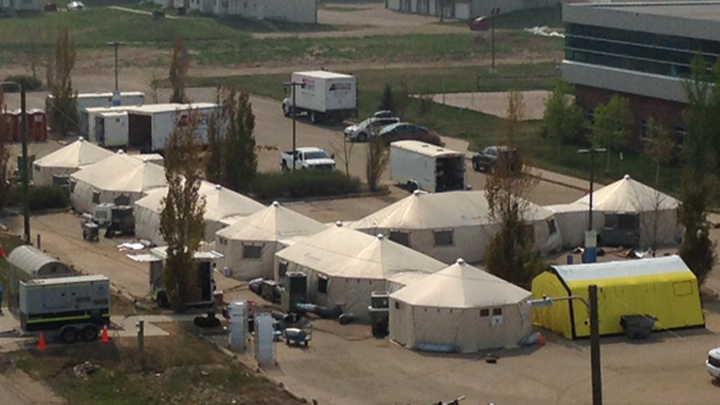
May 22, 2016

The Portable Isolation Containment Systems (PICS) units are a series of portable, inter-connected, modular shelters allowing AHS to provide healthcare with clean air, clean water and significant space.
FORT MCMURRAY - Sam Primerano remembers that when his community of High River was devastated by flooding in 2013, emergency services volunteers from Fort McMurray answered the call.
That’s why the Alberta Health Services (AHS) EMS Fleet Operations Team Lead didn’t hesitate when he got the call to lead a team to Fort McMurray to return the favour.
“It was an honour to go up there and give back,” says Primerano. “We know what they’re going through.”
Primerano led a 10-person team of Alberta Health Services EMS staff, from both Calgary and Edmonton, tasked with creating an Urgent Care Centre outside the Syncrude Sport and Wellness Centre, using Portable Isolation Containment Systems (PICS).
The PICS units are a series of portable, inter-connected, modular shelters allowing AHS to provide healthcare with clean air, clean water and significant space – all key factors that need to be addressed in a smoky environment without clean water.
“It was a huge task to accomplish what we did,” continued Primerano. “We had a great team and everyone worked together and we were able to get that up in two and a half days which is, I think, unprecedented for something that large. We’ve never built anything that large.”
The Urgent Care Centre includes four 20 x 40 foot rectangular shelters, five 20 x 20 foot octagon shelters, and five vestibules to connect the shelters. The Centre is supported with a HEPA filtered HVAC system, heating, air conditioning, a generator for power supply and interior lighting.
The urgency around creating the Urgent Care Centre was necessary to ensure emergency services were available to protect first responders, restoration workers and others in the community, as well as be ready for the return of residents.
“With the wildfires resulting in smoke and water damage to our hospital, the hospital requires a good deal of cleaning and restoration to bring it back up to hospital operating standards,” says Shelly Pusch, Chief Zone Officer, North Zone.
“This will take some time. In the meantime, we’ve ensured that we can care for people currently in Fort McMurray (first responders, restoration teams and surrounding oil sand workers), while being ready to meet our community’s healthcare needs on their re-entry to Fort McMurray.”
The Fort McMurray Urgent Care Centre is fully equipped to deal with significant urgent and emergent health issues with emergency care, laboratory services, X-ray and CT-scan capabilities, as well as an OR in the event that life or limb threatening conditions absolutely require surgery before transfer to tertiary care.
The UCC OR will only manage the potential for rare life-threatening surgical conditions where transferring the patient to Edmonton without surgery would add an unacceptable safety risk to patient care.
The Urgent Care Centre, which has over 30 patient care spaces, is fully equipped to deal with significant urgent and emergent health issues. It gives AHS the ability to provide a comparable level of care and treatment that one would expect from an emergency department.
The facility opened May 14th, 2016 and is available to anyone in Fort McMurray, including first responders, restoration workers, and anyone else in the city who requires medical care.
Almost 200 patients have been cared for at the FMUCC since it opened, and staffing will be ramped up before residents return in order to increase capacity to as many as 150 patients a day.
Patients requiring a higher level of care will be transported by ground and air ambulance until the Northern Lights Regional Health Centre re-opens. Additionally, three AHS EMS advanced life support ambulances and an AHS EMS supervisor will be available 24 hours a day to support the community.
"We will be able to manage a variety of the conditions that may arise as our community returns," says Dr. Kevin Worry, Medical Director, North Zone. "We are committed to providing 24/7 emergency level care for our community."
The PICS units meet relevant Infection Prevention and Control standards, Environmental Public Health standards, and as such are suitable for the uses currently in place, including an operating room.
The system’s air filtration and purification system provides air quality that meets Canadian Standards Association requirements for Canadian health facilities. The air quality and air pressure in the PICS units are comparable to that found in regular, permanent health care facilities.
AHS has used our PICS units a number of times in the past, including:
Primerano knows first-hand the devastation a natural disaster can have on a community, and is honoured to be part of the team effort to help.
“Any time you roll into a town and nobody is in it except first responders managing a natural disaster, it gets pretty eerie. To then to see the natural disaster’s damage, it hits home,” he says.
“We’re all pretty proud of being able to help in such challenging times.”